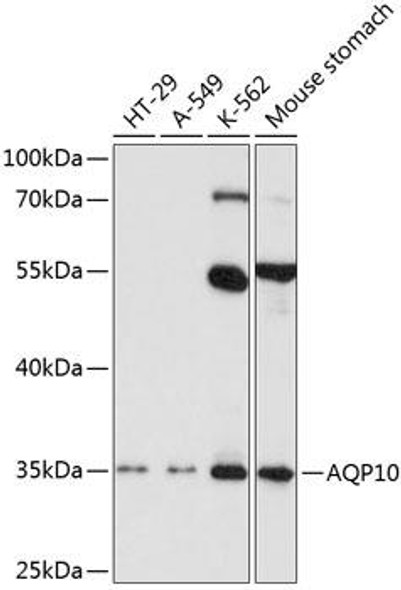Signal Transduction Antibodies 3
Anti-AQP1 Antibody (CAB4195)
- SKU:
- CAB4195
- Product Type:
- Antibody
- Reactivity:
- Human
- Reactivity:
- Mouse
- Reactivity:
- Rat
- Host Species:
- Rabbit
- Isotype:
- IgG
- Research Area:
- Signal Transduction
Description
| Antibody Name: | Anti-AQP1 Antibody |
| Antibody SKU: | CAB4195 |
| Antibody Size: | 20uL, 50uL, 100uL |
| Application: | WB IHC |
| Reactivity: | Human, Mouse, Rat |
| Host Species: | Rabbit |
| Immunogen: | A synthesized peptide derived from human AQP1 |
| Application: | WB IHC |
| Recommended Dilution: | WB 1:500 - 1:2000 IHC 1:50 - 1:200 |
| Reactivity: | Human, Mouse, Rat |
| Positive Samples: | Mouse liver, Rat spleen, Rat kidney |
| Immunogen: | A synthesized peptide derived from human AQP1 |
| Purification Method: | Affinity purification |
| Storage Buffer: | Store at -20'C. Avoid freeze / thaw cycles. Buffer: PBS with 0.02% sodium azide, 0.05% BSA, 50% glycerol, pH7.3. |
| Isotype: | IgG |
| Sequence: | Email for sequence |
| Gene ID: | 358 |
| Uniprot: | P29972 |
| Cellular Location: | |
| Calculated MW: | 28kDa |
| Observed MW: | 26KDa |
| Synonyms: | AQP-CHIP, CHIP28, CO |
| Background: | This gene encodes a small integral membrane protein with six bilayer spanning domains that functions as a water channel protein. This protein permits passive transport of water along an osmotic gradient. This gene is a possible candidate for disorders involving imbalance in ocular fluid movement. [provided by RefSeq, Aug 2016] |
| UniProt Protein Function: | AQP1: Forms a water-specific channel that provides the plasma membranes of red cells and kidney proximal tubules with high permeability to water, thereby permitting water to move in the direction of an osmotic gradient. Belongs to the MIP/aquaporin (TC 1.A.8) family. |
| UniProt Protein Details: | Protein type:Membrane protein, multi-pass; Membrane protein, integral; Transporter; Transporter, aquaporin family Chromosomal Location of Human Ortholog: 7p14 Cellular Component: nuclear membrane; apical part of cell; integral to plasma membrane; brush border membrane; basolateral plasma membrane; apical plasma membrane; cytoplasm; basal plasma membrane; plasma membrane; nerve terminal; nucleus; sarcolemma; brush border Molecular Function:protein binding; ephrin receptor binding; potassium channel activity; water transporter activity; intracellular cGMP activated cation channel activity; ammonium transmembrane transporter activity; glycerol transmembrane transporter activity; potassium ion transmembrane transporter activity; nitric oxide transporter activity; water channel activity; transmembrane transporter activity; glycerol channel activity Biological Process: cGMP biosynthetic process; glycerol transport; cerebrospinal fluid secretion; wound healing; cellular response to stress; water transport; carbon dioxide transport; negative regulation of caspase activity; sensory perception of pain; pancreatic juice secretion; positive regulation of saliva secretion; odontogenesis; positive regulation of fibroblast proliferation; nitric oxide transport; hyperosmotic salinity response; bicarbonate transport; multicellular organismal water homeostasis; cellular homeostasis; transmembrane transport; lipid digestion; potassium ion transport; lateral ventricle development; response to drug; cellular water homeostasis; secretory granule organization and biogenesis; glomerular filtration; ammonium transport; positive regulation of angiogenesis; renal water transport; camera-type eye morphogenesis; response to estrogen stimulus; adrenocorticotropin hormone secretion; establishment and/or maintenance of actin cytoskeleton polarity; renal water homeostasis; cell volume homeostasis; negative regulation of apoptosis Disease: Blood Group--colton |
| NCBI Summary: | Aquaporins are a family of small integral membrane proteins related to the major intrinsic protein (MIP or AQP0). This gene encodes an aquaporin which functions as a molecular water channel protein. It is a homotetramer with 6 bilayer spanning domains and N-glycosylation sites. The protein physically resembles channel proteins and is abundant in erythrocytes and renal tubes. The gene encoding this aquaporin is a possible candidate for disorders involving imbalance in ocular fluid movement. Several transcript variants encoding different isoforms have been found for this gene. [provided by RefSeq, Jun 2010] |
| UniProt Code: | P29972 |
| NCBI GenInfo Identifier: | 267412 |
| NCBI Gene ID: | 358 |
| NCBI Accession: | P29972.3 |
| UniProt Secondary Accession: | P29972,Q8TBI5, Q8TDC1, B5BU39, E7EM69, E9PC21, F5GY19 |
| UniProt Related Accession: | P29972 |
| Molecular Weight: | 16,677 Da |
| NCBI Full Name: | Aquaporin-1 |
| NCBI Synonym Full Names: | aquaporin 1 (Colton blood group) |
| NCBI Official Symbol: | AQP1 |
| NCBI Official Synonym Symbols: | CO; CHIP28; AQP-CHIP |
| NCBI Protein Information: | aquaporin-1; aquaporin-CHIP; urine water channel; channel-like integral membrane protein, 28-kDa; water channel protein for red blood cells and kidney proximal tubule; aquaporin 1 (channel-forming integral protein, 28kDa, CO blood group) |
| UniProt Protein Name: | Aquaporin-1 |
| UniProt Synonym Protein Names: | Aquaporin-CHIP; Urine water channel; Water channel protein for red blood cells and kidney proximal tubule |
| UniProt Gene Name: | AQP1 |
| UniProt Entry Name: | AQP1_HUMAN |







